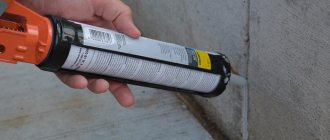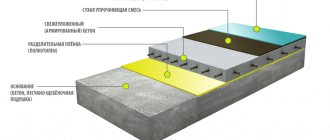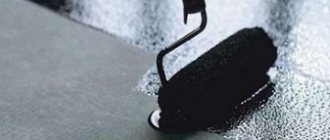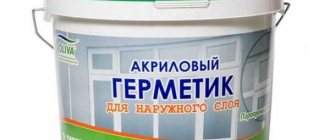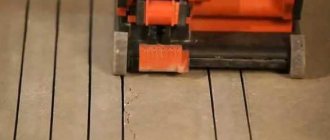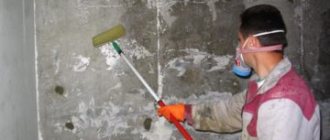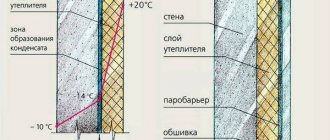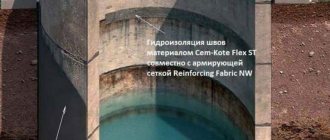Currently, many different types of cement have been developed and used for different conditions. Expandable cement is one type of material that is quickly gaining its place in the construction industry.
Expanding cement is a mass that begins to increase in size as the solution hardens.
Expanding cement entered the construction market not very long ago, but has already become indispensable in a number of specific construction projects. Its waterproofing parameters make it possible to use the composition in the most complex structures.
Features of the material
Expanding cement is a cement mass that increases in size as the mortar hardens. This effect is observed only in conditions of high humidity. Under normal conditions and dry weather, such material does not shrink during hardening.
The main property of the composition is the expandable volume of alumina-type cement with the introduction of a special additive with fairly rapid hardening of the mass.
Graph of strength growth during water storage of expanding cement.
The composition expansion mechanism is used to fill all (even microscopic) voids in the material, which ensures strength, solidity and high waterproofing properties of the structure. Expanding cement has found application in the construction of monolithic reinforced concrete systems, since during expansion it ensures the filling of all voids in the frame. In general, its purpose is quite specific: filling cracked concrete; production of structures operating in water or high humidity; gluing reinforced concrete structures; plastering complex surfaces (for example, shell rock).
Due to its ability to fill all air formations in concrete, expanding cement acquires unique water resistance. Due to expansion, the composition has increased adhesion to almost any material, which makes it possible to cladding walls of unusual designs. Important advantages include fairly high durability and resistance to aggressive influences.
The main disadvantage of such cement is its high price, which somewhat limits its use in private construction. It should be used for its intended purpose: in structural elements that are located in water or exposed to prolonged exposure to high humidity (basements, some foundations and plinths, floor screeds; walls of swimming pools, wells, tanks, etc.).
Advantages and disadvantages
Like any building material, expansive cement has its pros and cons. Clear advantages include:
- durability,
- possibility of filling micro and macro cracks,
- Possibility of use as a finishing plaster,
- increased adhesion,
- resistance to atmospheric and chemical influences.
Important: in addition to expanding ones, there are other additional components. They determine the type of resistance of cement. Some are ideal for external work, others are specifically designed for use in chemically active environments, and others are distinguished by improved adhesion, which is important when assembling reinforced concrete structures. Therefore, before buying cement, you need to accurately determine its type.
The disadvantages of the material are the following:
- high price,
- bad distribution
- the presence of a large number of fakes on the market,
- narrow profile.
Despite this, if you buy a product from a trusted manufacturer and use it for its intended purpose, then the savings on other materials will more than cover the cost of the cement itself.
Types of Expandable Cement
Expandable cement has the following main types:
Scheme of a fence made of expanding cement.
- waterproof expanding composition;
- gypsum-alumina expanding material;
- expanding cement;
- tensile cement;
- plasticized expanding cement.
Despite noticeable differences in properties, all types are based on alumina-type cement or a mixture of cements that include the alumina element.
In order for the material to fulfill its functional purpose, a special active additive is introduced into it. The main types of such additives can be distinguished:
- calcium hydrosulfoaluminate;
- magnesium oxide hydrate;
- aluminum and calcium chloride sulfates;
- sulfite-alcohol stillage;
- aluminum powder;
- alunite.
As the most inexpensive, the first additive has found the most widespread use, although the most effective is magnesium oxide hydrate.
Waterproof composition
Waterproof expanding cement is designed to waterproof a structure. Concrete based on it can even be used in the construction of dams and dams. At the same time, compared to other types of such compositions, it has the lowest volumetric expansion. This property should be used when preparing plaster solutions for covering walls located in difficult wet conditions.
Scheme of cement production using dry and wet methods.
Waterproof cement is a dry mixture of aluminous cement, semi-hydrous gypsum and highly basic calcium aluminate. The additive in the form of aluminate is obtained by thermal exposure (up to 150°) for 6 hours to a mixture of aluminous cement with lime (in equal proportions) and water. The binder and additive are thoroughly mixed and ground dry.
When water is added to cement, a reaction occurs with the appearance of an expanding volume. The mixture tends to harden quickly, so within 3 minutes the process of setting the mass begins, which is completed after 10 minutes. If there is a need to slow down the hardening of the solution, then borax or acetic acid is added.
The complete hardening process of the solution inside ends after 25-28 hours, depending on the temperature. Volumetric expansion of the mass occurs only at high humidity (at least 70%). The degree of expansion of the standard solution is standardized: the linear expansion of cement after 24 hours should be within 0.2-1% (no more and no less). The expanded cement mass increases with increasing humidity.
Internal expansion, which continues for quite a long time, leads to a gradual increase in the strength of the composition. 3 days after application, the cement must meet the parameters of grade M300, and after 28 days - M500.
The better liquid sealant for heating repairs
The increased heat resistance of some special sealants makes it possible to use them for prompt repair of heating boilers.
For heating repairs, it is not always possible to use external agents. What to do, for example, if the location of the leak cannot be detected because the house had hidden pipes and installed a heated floor? Will we really have to break down the walls and open up the floors? No, you don't have to! In such situations, a relatively new method of eliminating leaks is used - by pouring liquid sealant for heating pipes into the system. This sealant is also suitable for radiators when it is not possible to apply a clamp to a leak.
The fundamental difference between liquid sealants for heating systems is their ability to eliminate leaks not by applying to the damaged area from the outside, but directly from the inside.
In an emergency, it is permissible to pour sealant intended for car radiators into the heating system
The essence of this method is that when mixed with a coolant, the sealant remains liquid, and only upon contact with air penetrating into the system does it polymerize. Gradually hardening, the sealant clots are sealed from the inside of the crack exactly in those places where the integrity of the system is compromised.
Several types of liquid sealants for heating are produced, each of which is adapted to special conditions of use, in particular:
- the coolant is water or antifreeze;
- gas or solid fuel boiler;
- heating or water pipes.
You should not try to look for one universal sealant for your home heating system. It is better to purchase a specialized composition for the specific parameters of your heating system.
The most famous among consumers are liquid sealants for heating systems produced by the German company BCG. The use of these products is considered an ideal solution for eliminating hidden coolant leaks. When used correctly, liquid sealant does not pose a danger to heating boilers and does not cause damage to the circulation pump and measuring instruments.
Sealant for pipes and heating radiators must remain in the system for a long time. Once you add this sealant to your heating system, you can forget about leaks for several years.
Sealants for closed heating systems eliminate pressure losses associated only with leaks in pipes and radiators, but are powerless in cases where the membrane in the expansion tank is damaged.
Gypsum-alumina composition
table for the use of cement mortars.
Expanding type gypsum-alumina cement is very similar in properties to the waterproof cement considered; its main purpose is waterproofing concrete structures. Its binder composition is a mixture of aluminous clinker or slag with natural gypsum of the dihydrate class. This cement is especially good for sealing joints in structures operating in water.
A coating made of gypsum-alumina mortar, after hardening, has greater compressive strength. The process of complete hardening takes 70-80 hours. The price of this material is somewhat more expensive than waterproof cement.
Expanding cement composition
Expanding Portland cement (EPC) has very high strength and is often used in the construction of monolithic structures. At the same time, it does not have uniform linear expansion, which precludes its use in plaster mortar or other facing mixtures. Its waterproofing properties are at a high level.
Graph of water to cement ratio for different grades of cement.
RPC is prepared on the basis of the following mixture: Portland cement clinker (58-65%), aluminous slag (5-7%), natural gypsum (7-10%), blast furnace slag or mineral filler (20-30%). For active expansion of the solution, a moist environment is needed, but not water. When immersed in water, the composition does not expand. In this regard, the process of forming the ROC is carried out with a short one-time steaming. Full hardening is achieved after 70-80 hours of drying. The heated steam atmosphere reduces the hardening time to 35 hours. After this, the material acquires high mechanical strength and water resistance.
How does the sealing effect manifest itself?
You should not expect the leak to be eliminated immediately, but only on the 3rd or 4th day. During this time, the sealant for heating pipes will compact and close the cracks in problem areas from the inside. Eliminating the problem of coolant leakage will manifest itself in the fact that the sound of falling drops of liquid will no longer be heard in the house, moistened areas on the floor will dry out, and the pressure in the system will no longer decrease.
At the same time, one of the negative effects may be a slight blockage of passages in devices for distributing coolant flow, as well as in thermostats. But this problem can be easily solved by periodically opening and then adjusting these types of regulators to the desired position to prevent them from further sticking.
When working with liquid sealant for heating systems, the same strict precautions must be observed as those prescribed for working with all kinds of chemicals!
The video lesson will help you understand how to fix a leak in your heating system yourself using liquid sealant.
Based on all that has been said, you can be sure that liquid sealant is undoubtedly worth using to eliminate leaks in the heating system. Even though its price is steep. However, it should be understood that hidden installation of heating pipes is not only a convenience, but also a certain risk, for which you sometimes have to pay.
Tensile cement
Tensile cement is specially designed for repairing concrete and reinforced concrete. It copes well with emerging cracks and other defects. When applied, this material first hardens, and only then expands and thus strains the concrete structure, filling all air pores and cracks.
Effect of lime addition on deformation and self-stress of NC.
Tensing cement has the following composition: Portland cement (65-75%), aluminous cement (12-20%) and gypsum (up to 10%). The expansion process begins upon contact with water. This cement can be applied 0.5 hours after watering. The solution sets within 4 hours, and final hardening occurs within 70-75 hours. The material has very high strength, which after 24 hours should be more than 15 MPa (finally, after 28 days - 50 MPa).
The tensing composition with the expanding component alunite (salt of aluminum and potassium sulfate) has proven to be quite effective. This cement has the following composition: Portland cement - 65%, gypsum - 10%, lime - 4%, alunite - 21%. Among the foreign analogues, one can note a mixture of Klein with an expanding element - sulfatoaluminate clinker.
Steps to eliminate a leak with liquid sealant
Before you start sealing possible leaks in the heating system, you need to make sure that the expansion tank is in good condition.
The procedure for using liquid sealants to repair a home heating system may seem quite complicated. In some cases, clots of sealing fluid cause partial blockage and impede the movement of the coolant. Therefore, in order not to cause damage to the heating equipment due to your inexperience, it is better to invite a specialist. In any case, you need to study the instructions for using a specific type of sealant for radiators and strictly follow them.
Having decided to use a liquid sealant to fix a problem in the heating system, you need to make sure that:
- the reason for the pressure drop is precisely the leakage of coolant, and is not related to a malfunction of the expansion tank;
- the selected type of sealant for heating systems corresponds to the type of coolant in the system;
- The sealant is suitable for this heating boiler.
German liquid sealant BCG-24 is used to eliminate leaks in heating systems
When using liquid sealant for pipes and radiators, it is important to maintain the correct concentration. On average, its values range from 1:50 to 1:100, but it is advisable to determine the concentration more accurately, since the effectiveness of eliminating leaks can be affected by factors such as:
- coolant leak rate (up to 30 liters per day or more);
- the total volume of water in a given heating system.
If the volume does not exceed 80 liters, 1 liter of sealant will be enough to pour into the heating system. But how can we more accurately calculate the volume of water in the system? You need to calculate how many meters of pipes and what diameter were laid in the house, and then enter this data into one of the online calculators. To the resulting volume of pipelines, you must also add the passport characteristics of the volumes of all radiators and the boiler.
You can drain all the water from the system into a certain container, the volume of which is precisely known, and then fill the system again.
Preparing the heating system
- Dismantle or cut off all filters with taps so that they do not become clogged with a viscous solution of sealant for heating systems;
- Unscrew the Mayevsky valve from one radiator (the first one in the direction of coolant flow) and connect a pump to it (the “Baby” type);
- Start the heating system and let it warm up for an hour to a temperature of 50–60°C at a pressure of at least 1 bar;
- Open all taps on pipelines and radiators to allow sealant to flow freely through them;
- Remove air from the entire system, including the radiators and circulation pump.
If the air is not completely vented, it will begin to react with the sealant and cause it to thicken in places other than where it is needed to eliminate the leak.
Preparing the sealant
You can also pour liquid sealant into the heating system using a hand pump for pressure testing.
Drain about 10 liters of hot water from the system into a large bucket, most of which is used to prepare the sealant solution, and leave a few liters for subsequent flushing of the pump;- Shake the canister (bottle) with sealant for radiators and heating pipes, then pour its contents into a bucket;
- Rinse the canister thoroughly with hot water so that all remaining sediment gets into the solution being prepared.
Solutions of sealants for heating systems must be prepared immediately before use so that the liquid does not come into contact with atmospheric air for too long.
Pouring sealant
Liquid sealant for heating systems must have time to mix with the coolant before it reaches the boiler, so it is more advisable to pour it into the supply:
- Introduce liquid sealant solution into the system using a pump;
- Pump the remaining hot water through the pump so that absolutely all of the sealant sediment gets into the system;
- Bleed the air from the system again;
- Raise the pressure to 1.2–1.5 bar and maintain the system operating cycle for 7–8 hours at a temperature of 45–60°C. This period is needed for the sealant to completely dissolve in the coolant.
The operation of heating equipment cannot be stopped for several days until the polymerization of the liquid heating sealant is completed.
Plasticized cement
Plasticized expanding compound is a recent development in this field. It is not yet available in Russia. Foreign companies offer a material based on Portland cement with plasticizers and an expanding ingredient in the form of sulfite-alcohol stillage. Due to its increased plasticity, such a solution is used to cover large areas (floors, roads, etc.).
When preparing expanding cement mortars, the following tools should be used:
- construction mixer;
- construction hair dryer;
- scales;
- measuring bucket;
- shovel;
- putty knife;
- Master OK;
- knife;
- file;
- sandpaper.
Expanding cements make up a number of modern high-quality building materials. Their use is somewhat limited by price, but their waterproofing and strength properties inspire confidence in them.
Areas of use
Expanding trains are characterized by a narrow focus. They are not used in general construction and finishing works due to the high cost of the product.
- Compositions are used to fill formed micro- and macrocracks in reinforced concrete structures.
- Acting as a binder, the injected or applied cement tightens the edges of the gaps, leaving no room for condensation, corrosion and new growth.
- Plastering facades made of porous materials. Everything is simple here, in order to reduce the use of general building mixtures during finishing, expanding concrete is applied. When it gets into the structure of the material, it takes on its shape without leaving any depressions. The result is a monolith that is resistant to weather changes.
- Miners use cement for exploration and hard work in hard-to-reach areas: they use it instead of blasting to get large parts of deposits.
- The mixture is poured into the trenches placed under the desired area.
- As it sets, it occupies the entire space, pushing out huge pieces.
To literally build for centuries, they use a composition to create a strong monolithic connection between the walls and floors of houses. When applying cement, an impermeable material is obtained that can evenly distribute the load.
Information sources:
- GOST 11052-74 (introduced 01/01/1976).
